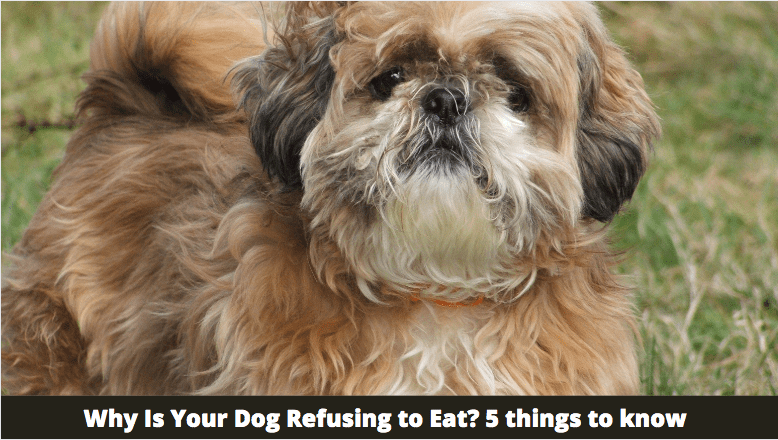Why Is Your Dog Refusing to Eat?
You’ve noticed that your dog hasn’t been eating his food recently, and you’re not sure what to do.
What you really want to know is how to persuade a dog to eat again, and more crucially, how to determine what caused him to stop eating in the first place.
Take the time to figure out why your dog isn’t eating and what you can do to help.
Sign of Stress for your dog
Events that are stressful to your dog, as well as changes in his environment may be the root of his temporary refusal to consume food. Is there anything new in your pet’s life that you want to share?
Things like a move to a new home or enrolling in doggy daycare might be significant, but minor events like a family member going away for the weekend can also be significant.
These changes in your pet’s environment may have an impact on his eating habits.
While this is worrying, it is important to remember that stressful situations and environmental changes are typically only temporary problems.
Consult with your veterinarian if the symptoms persist for an extended period of time or if your dog exhibits other signs of stress and anxiety (such as soiling the house or damaging furniture).
Change in your dog’s Diet
It’s possible that a shift in cuisine is to blame as well. Dogs, like people, have strong feelings about the food they eat and don’t eat as much as they should.
A simple snub of the nose may be all that’s wrong with your pet’s food, especially if you’ve just switched flavours or brands.
Don’t rule out the possibility that the food you’re providing your pet has gone bad; make sure to check the expiration date on the container before serving it to your pet.
If your dog is a fussy eater, you can benefit from the following helpful hints.
Illness or Loss of appetite
Loss of appetite in your pet could be a key indicator that anything is physically wrong with him. It’s possible that your dog is suffering from dental issues, making it harder for him to chew and swallow.
An infection, cancer, or liver failure are all possible medical conditions to be concerned about. If you feel that your pet’s sudden refusal to eat is the result of an illness, schedule an appointment with your veterinarian as soon as possible to have some tests performed.
Look for any other indicators, aside from not eating, that would indicate a health-related reason for the absence of food.
For example, if your dog has been vomiting or hasn’t pooped in a couple of days, he may be suffering from gastrointestinal discomfort. Is he acting in an especially sluggish or reserved manner?
In most cases, a dog who is still energetic and excited indicates that he is in good health, so it is possible that he is just being fussy.
However, not eating in conjunction with other indicators might be a solid indication of a health risk, and you should take him to the veterinarian to be looked out.
You should also make sure he is getting enough water.
In the event that he is not eating but is drinking water, it is possible that he is simply a picky eater.
Keep an eye on him for a couple of days to see if his appetite changes. If this is the case, and he is still only drinking water, you should visit your veterinarian.
It is critical that you contact your veterinarian as soon as possible if he is not eating or drinking. Dogs should not be allowed to go more than one day without drinking water.
Another possible reason for your dog’s decreased appetite could be medication. While medications and immunizations can help keep your dog healthy, sometimes an animal will have adverse effects as a result of these treatments.
You should keep an eye on your dog after he has received medication and contact your veterinarian if his lack of appetite persists for more than 24 hours.
Instructions on How to Get a Dog to Eat
The sooner you can figure out why your dog is refusing to eat, the better off you will be. In certain cases, treating the underlying problem can help your pet return to a normal eating pattern.
If the problem persists, there are a few things you may do to get your pet to start eating again.
First and foremost, are you providing your dog with table scraps or overfeeding him with treats? If this is the case, discontinue immediately.
Regular mealtimes, rather than off-the-clock snacking, are the foundation of healthy eating.
Changing the way you feed your dog may also be beneficial. For example, if your furry companion is experiencing anxiety, you might want to explore feeding him in a separate area from the rest of the household.
If he’s getting tired with eating, make dinner time more enjoyable by utilizing a puzzle or toy that dispenses his food for him.
Finally, if you are unable to convince your dog to eat healthy, normal meals again, it is recommended to schedule an appointment with your veterinarian.
Going without eating for an extended period of time might result in malnutrition or dehydration. Your veterinarian will assist you in determining the cause of your dog’s lack of appetite as well as provide you with suggestions on how to get him to eat again.
Fact-Finding:
Thanks for reading and have a great day! Why dog refusing to eat, dog refusing to eat, why dog refusing to eat, why dog not eating?
Please post your thoughts in the comments section if you have any. Please feel free to share!

